|
|
Vol.
28 No. 2
March-April 2006
Art
and Science: Looking in the Same Direction
by
Maria Clara F.Magalhães and Rosa Maria Oliveira
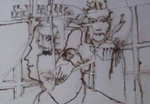 |
| Drawing
by Isabel Seruca |
The
present cultural convergence of art, science, and technology
provides ample opportunity for artists and scientists to examine
how these various areas of knowledge influence one another.
We live in a time characterized by cross-disciplinary interaction,
and those in the arts and sciences must develop new approaches
to face the challenge of working together. If successful in
meeting this challenge, innovators in these fields will be
able to create exciting new art forms and achieve creative
and useful technological innovations.
Relationship
Between Art and Science
From prehistoric times to the Renaissance, there was little
distinction drawn between art and science—both were
viewed as important aspects of culture, driven by creativity.
The Renaissance, however, initiated an era of specialization
during which art and science began to move in different directions,
intersecting only occasionally. Until recently it has been
taken for granted that art and science have followed different
paths, characterized by different languages and world views,
making communication between participants in these two human
pursuits nearly impossible.
In today’s world, however, some artists have begun to
study and employ the concepts, tools, and contexts of scientific
and technological research, and advances in technology increasingly
allow the artist to operate outside the conventions of traditional
practice. We believe that during the 21st century, this trend
will continue to evolve and become more widespread, leading
to new techniques and materials and new aesthetic perspectives
that will be used to convey artists’ unique conceptual
experiences of the world.1
Chemistry's Role in Art
Even as far back as the stone age, the ancient relationship
between art and chemistry can be perceived in early humans’
recognition and exploitation of differences in the properties
of natural dyes and pigments in terms of color, transparency,
and texture, and in the use of water and fire in the transformation
of these materials. Throughout history, the discovery of new
minerals and other materials has led to new aesthetic possibilities.
In modern times, chemistry—as the science of the properties
of materials, and of their transformations—has continued
to serve as a source of inspiration for art. And artistic
pursuits in turn influence work in chemistry. Jewelry-making
and sculpture lead to the development of new alloys, and the
visual arts and architecture motivate research into new materials
with unique chemical compositions, structures, particle sizes
and shapes, and stability in reaction to light and weather.
Science also enables us to deepen our knowledge of artistic
masterpieces by using a plethora of analytical techniques
to investigate the composition of the materials used, their
origins, and the artist’s technique, as well as ultimately
helping to determine the authenticity of the pieces themselves.
Our reflections concerning the links between chemistry and
art arose from the exhibition Solubility: Art and Science,
presented at the 11th International Symposium on Solubility
Phenomena Including Related Equilibrium Processes, held in
Aveiro, Portugal, in July 2004. This discussion touches on
several different connections between chemistry and art, including
art and chemistry as mutual sources of inspiration, the properties
(specifically solubility) of materials, and some of the associated
techniques used in creating works of art.
Art and Chemistry as Mutual Sources
of Inspiration
Pursuits in both the arts and sciences are strongly influenced
by the emotions of the individuals who undertake them, as
well as by numerous social and aesthetic influences. Creativity
is one of the common drives of all human beings, and we must
not forget its importance in scientific work and in the evolution
of modern society in general. For example, Nobel Prize winners
Roald Hoffman2 and Jean-Marie Lehn3
call attention to the importance of creativity in chemistry,
particularly in the synthesis of new molecules and materials,
with wholly new properties, that have not previously existed
on earth, as a most obvious expression of the similarity of
approaches to chemistry and art. Like artists, chemists combine
existing elements in previously unknown ways to create something
entirely new. And like art, science seeks to bridge previously
disparate areas of knowledge, allowing scientists to look
at materials in new and different ways, and to make unexpected
associations that lead to new discoveries. In science, as
in art, it is necessary to tap into imagination and creativity
in order to rise above accepted knowledge and practice to
create new models and theories that can stimulate or accommodate
new knowledge.
Scientists work within their own epoch, and sometimes it takes
an outside influence to allow mental barriers to be broken
down. One example is the discovery of a whole family of carbon
allotropes named fullerenes, in which the carbon atoms are
arranged in spherical or ellipsoidal structures. Harold Kroto
made this discovery after recognizing the structural significance
of the geodesic domes built by twentiethcentury architect
R. Buckminster Fuller.
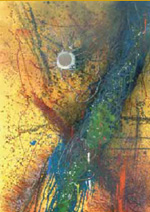 |
| Fig.
1 Oil
on Canvas by Susana Távora |
Science
in general, and chemistry in particular, can also be a source
of inspiration for artists. In literature,
the beautiful passages on the subject of water in James Joyce’s
Ulysses merit particular attention. The confluence
of science and art can also be enjoyed in the books Chemistry
Imagined, Reflections on Science (Smithsonian Institution
Press, Washington and London, 1993), by Roald Hoffman and
Vivian Torrence, and Crossing Over, Where Art and Science
Meet (Three Rivers Press, New York, 2000), by Stephen
Jay Gould and Rosamond Wolff Purcell. These two very different
works were produced by very different scientific and artistic
personalities who nevertheless share a passion for their work
and an ability to make science clear, stimulating, and highly
enjoyable to the general public.
It should also be noted that although scientific papers are
not normally an arena for presenting original works of art,
popular articles on science often rely on artistic renderings
to introduce concepts and make them understandable to the
reader.
Artistic Materials and Their Properties
As well as serving as mutual sources of inspiration, chemistry
and art also influence each other in the realm of the physical.
Progress in the study of chemistry, for example, brings new
techniques and materials to the art world. Research on artistic
mediums and materials is relevant to a whole host of artistic
fields, including painting, sculpture, photography, holography,
cinema, engraving, stained glass, architecture, jewelry-making,
perfumery, and textiles. And detailed analysis of the materials
and construction of certain paintings and other works of art
can afford us insight into the scientific ideas of the artist’s
own epoch, and of the artist him or herself. The mutual influence
between DaVinci’s pursuits in the fine arts and his
studies in anatomy, mechanics, and optics are perhaps the
best example.
Among the large range of properties of materials that influence
artistic expression, solubility was chosen as the particular
subject of the exhibition Solubility: Art and Science.
Solubility is important in differentiating pigments from dyes.
Both types of materials are
natural or synthetic substances used to impart color to another
substance, but pigments are powdered substances used in suspension—they
are practically insoluble in solvents and binders—whereas
dyes are applied in solution. The study of chemistry has been
indispensable in the development of both types of materials,
from the prehistoric use of natural pigments
to the development of modern synthetic dyes. And throughout
history, the new colors and techniques made possible by chemistry
have had a great influence on the development of art.
Artistic Techniques Presented at the
Exhibition
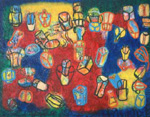 |
|
Fig. 2 (above)- Oil
on canvas by Isabel Azevedo |
 |
| Fig.
3 - Watercolor
by Manuela Oliveira |
The
works of art presented in the Solubility: Art and Science
exhibition were created using many different technologies
and materials, and they represent various forms of artistic
expression. Each work of art is unique, even among those produced
by the same artist. However, every great artist is aware that
he or she must take into consideration the specific properties
and limitations of the technology or materials used to produce
a work.
Painting:
The paintings presented in the exhibition included oil on canvas (Figure 1 and 2), in which the materials used are colorants, both organic and synthetic, mixed with
linseed oil and white spirit, allowing the artist to apply successive layers to achieve the desired colors and to give the illusion of shape and volume. This technique has been in wide use since the 15th century. Other paintings in the exhibition were created with watercolors (Figure 3), in which transparency is fundamental. The colorants used are soluble in water. The stroke of the paintbrush must be secure and firm—hesitation leads to failure, and corrections are not possible. The use of acrylics (Figure 4) is a relatively recent development.
Acrylics are soluble in water, but still allow the artist to work in successive layers and to achieve various textures. They dry very quickly, however. In each of these cases, the specific characteristics of the materials used have a profound influence on the technique employed by the artist, and thus on the emotion conveyed by the final work.
Drawing:
The drawings presented in the exhibition were created using
ink and graphite, which have traditionally been used to achieve
different tonalities of light and shadow, and thus give the
illusion of depth and volume (Figure 5 and figure at top of
article).
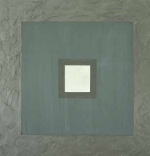 |
 |
| Fig.
4 - Acrylics
by Chuva Vasco |
Fig.
5 - Drawing
by Isabel Seruca |
Serigraphy:
Serigraphy (Figure 6) is used to produce multiple copies of
a work. The artist applies beeswax to a fine net of silk or
nylon to create a kind of stencil for each color used. This
stencil is then placed over a sheet of paper, and colorants
are mixed with white spirit and spread out over the netting,
transferring to the paper through those areas to which beeswax
has not been applied. This process is repeated for each color
used in the work.
 |
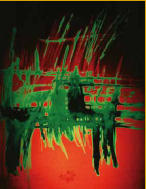 |
| Fig.
6 - Serigraphy
by Isabel Maria Dos |
Fig.
7 - Holography
by Rosa Maria Oliveira |
Holography:
This technique (Figure 7) represents a close relationship
between art and science. Holography is based on the principles
of physics, using coherent light. A recording of the image
is made on a plate of film or glass coated with a light-sensitive
emulsion. After imaging, the plate or film is developed in
variouschemical developers and bleachers in order to develop
and fix the recorded image. The holograms presented in the
exhibition were also preswollen in different solutions of
triethanolamine to achieve multicolored final images. The
colors attained are determined by controlling the preswelling
of the emulsion.
As
can clearly be seen from the illustrations, the specific characteristics
of the materials used have a profound influence on the technique
employed by the artist, and on the emotion conveyed by the
final work of art.
Acknowledgments
The authors would like to express their deep appreciation to each of the artists who contributed to the exhibition, and to all the conference participants for their interest. Special thanks also go to professor Glenn Hefter for his comments on this text.
Maria Clara F. Magalhães <[email protected]> is a professor in the Department of Chemistry, and Rosa Maria Oliveira is a professor in the Department of Communication and Art, at the University of Aveiro, Aveiro, Portugal.
References
1. Stephen Wilson, Information Arts, Intersection of Art, Science
and Technology, The MIT Press, 2002.
2. Roald Hoffman, “Por trás do artigo de química,” Química,
Boletim da Sociedade Portuguesa de Química, 1993, Série II, 50,
44, and “In praise of Synthesis,” American Scientist, 1991, 79, 11.
3. Jean-Marie Lehn, text for the exhibition “Art of Chemistry—
Alchemy of Art,” conceived by the Centre National de la
Recherche Scientifique (CNRS) for FAUST 1990—Forum des
Arts de l’Univers Scientifique et Technique, France.
Page
last modified 8 August 2006.
Copyright © 2003-2006 International Union of Pure and
Applied Chemistry.
Questions regarding the website, please contact [email protected]
|